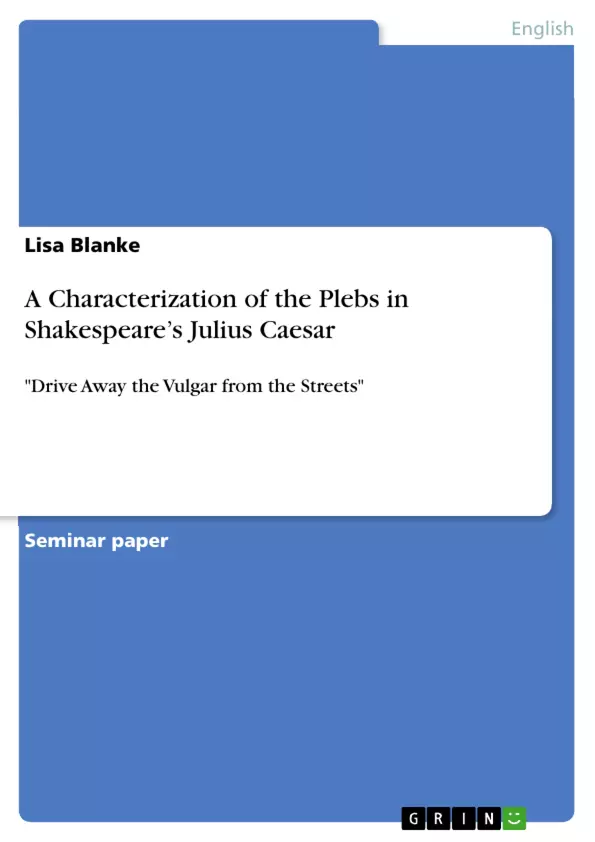The first associations with William Shakespeare’s Julius Caesar are generally the main characters Caesar and Brutus and the consequent conflict between loyalty to a friend and the common good. Furthermore there are the conspirators or other important characters known from history, but there is an important “figure” which is more essential than it seems at first sight: the plebs.
A major part of the play is about Brutus´ struggle about the common good. In
fact he never puts this into concrete terms. “For the good of Rome” (JC 3.3.45) should be the same as ‘for the good of the plebeians’, since they are the biggest group of people living in Rome. What exactly Brutus meant by that stays vague. In contrast to this it is obvious that in the end the plebeians not only lose their beloved Caesar but also the most important thing in a community: peace. Cassius characterizes the plebs “sheep” (JC 1.3.105), “trash” (JC 1.3.108) and “offal” (JC 1.3.109). Nevertheless the plebs are at the same time (evident) reason for the conspiracy and reason for its failure, thus symbols of the ambiguity of the conspirators intentions. Their characteristics are crucial for the process of the tragedy.
In the following chapters I am going to characterize the plebeians on the basis of their development in the course of the play, focusing on the three scenes in which they appear and then subsequently elaborate their attributes.
Inhaltsverzeichnis (Table of Contents)
- Introduction
- "Home, You Idle Creatures"
- Funeral of Caesar - Birth of the Mob
- "Be Patient till the Last"
- "You Gentle Romans"
- "We Will Be Satisfied"
- "Tear Him to Pieces"
- Conclusion
Zielsetzung und Themenschwerpunkte (Objectives and Key Themes)
The main objective of this essay is to analyze the characterization of the plebeians in Shakespeare's Julius Caesar, focusing on their role in the play's political and social dynamics. This analysis will explore the plebeians' evolving attributes as they navigate the unfolding drama, highlighting their influence on the course of the play and the tragic events that unfold.
- The social and political hierarchy in Rome and its impact on the plebeians
- The conflict between the tribunes and the plebeians, representing a clash of interests and power dynamics
- The manipulation and influence of the plebeians by the conspirators and other characters
- The role of the plebeians in shaping the tragic events of the play, particularly in the aftermath of Caesar's assassination
- The ambiguity of the plebeians' motives and actions, reflecting the complexities of the political landscape in Rome
Zusammenfassung der Kapitel (Chapter Summaries)
The first chapter of this essay examines the initial encounter between the tribunes and the plebeians in Julius Caesar. The scene provides insights into the social hierarchy, the conflict of interests, and the dynamics of power within Roman society. The chapter explores how the cobbler, a key representative of the plebeians, challenges the authority of the tribunes, showcasing the potential for unrest and social upheaval.
The second chapter analyzes the plebeians' reaction to Caesar's assassination, focusing on their shifting attitudes and actions. The chapter examines how the plebeians are manipulated by the conspirators, eventually turning against Brutus and fueling the conflict. This chapter explores the influence of emotions like anger and grief on the plebeians' behavior and their impact on the political landscape.
Schlüsselwörter (Keywords)
This analysis focuses on the themes of political intrigue, social hierarchy, plebeian manipulation, and the role of the common people in shaping the course of history. The key concepts examined include the conflict between the tribunes and the plebeians, the evolution of plebeian characterization, and the impact of popular opinion on political events.
- Quote paper
- Lisa Blanke (Author), 2012, A Characterization of the Plebs in Shakespeare’s Julius Caesar, Munich, GRIN Verlag, https://www.grin.com/document/264210



